
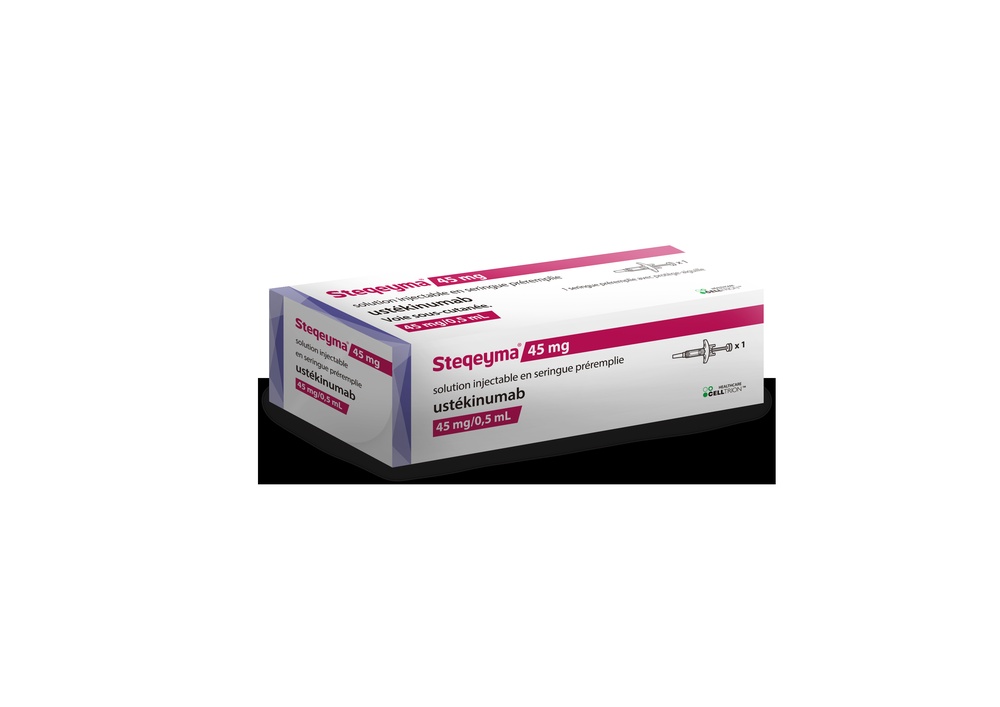
СТЕКЕЙМА 45 мг Розчин для ін'єкцій у попередньо заповненому шприці


Інструкція із застосування СТЕКЕЙМА 45 мг Розчин для ін'єкцій у попередньо заповненому шприці
Введення
Опис: інформація для пацієнта
Цей лікарський засіб підлягає додатковому моніторингу, що прискорить виявлення нової інформації про його безпеку. Ви можете допомогти, повідомивши про будь-які побічні ефекти, які ви могли б мати. Остання частина розділу 4 містить інформацію про те, як повідомляти про ці побічні ефекти.
Прочитайте уважно весь опис перед тим, як почати використовувати цей лікарський засіб, оскільки він містить важливу інформацію для вас.
Цей опис написаний для особи, яка використовує лікарський засіб. Якщо ви батько або опікун дитини, якій буде призначено Steqeyma, будь ласка, прочитайте цю інформацію уважно.
- Збережіть цей опис, оскільки вам може знадобитися знову його прочитати.
- Якщо у вас є якісь питання, проконсультуйтеся з вашим лікарем або фармацевтом.
- Цей лікарський засіб призначено тільки вам, і не слід давати його іншим людям, навіть якщо вони мають такі самі симптоми, як і ви, оскільки це може їм нашкодити.
- Якщо ви відчуваєте побічні ефекти, проконсультуйтеся з вашим лікарем або фармацевтом, навіть якщо це побічні ефекти, які не вказані в цьому описі. Див. розділ 4.
Зміст опису
- Що таке Steqeyma і для чого вона використовується
- Що потрібно знати перед тим, як почати використовувати Steqeyma
- Як використовувати Steqeyma
- Можливі побічні ефекти
- Зберігання Steqeyma
- Зміст упаковки та додаткова інформація
1. Що таке Steqeyma і для чого вона використовується
Що таке Steqeyma
Steqeyma містить активну речовину "устекінумаб", моноклональне антитіло. Моноклональні антитіла - це білки, які ідентифікують і специфічно зв'язуються з певними білками організму.
Steqeyma належить до групи лікарських засобів, званих "імунодепресантами". Ці лікарські засоби діють шляхом ослаблення частини імунної системи.
Для чого використовується Steqeyma
Steqeyma використовується для лікування наступних запальних захворювань:
- Псоріаз пластинчастий - у дорослих і дітей від 6 років і старше
- Псоріатичний артрит - у дорослих
- Хвороба Крона середньої та важкої форми - у дорослих
Псоріаз пластинчастий
Псоріаз пластинчастий - це захворювання шкіри, яке викликає запалення, що впливає на шкіру і нігті. Steqeyma зменшує запалення і інші ознаки захворювання.
Steqeyma використовується у дорослих з псоріазом пластинчастим середньої та важкої форми, які не можуть використовувати циклоспорин, метотрексат або фототерапію, або якщо ці лікування не діють.
Steqeyma використовується у дітей і підлітків від 6 років і старше з псоріазом пластинчастим середньої та важкої форми, які не можуть переносити фототерапію або інші системні терапії, або якщо ці лікування не діють.
Псоріатичний артрит
Псоріатичний артрит - це запальне захворювання суглобів, яке зазвичай супроводжується псоріазом. Якщо у вас є активний псоріатичний артрит, спочатку ви будете приймати інші лікарські засоби. Якщо ви не реагуєте добре на ці лікарські засоби, ви можете бути призначені Steqeyma для:
- Зменшення ознак і симптомів захворювання.
- Поліпшення вашої фізичної функції.
- Зменшення ушкодження суглобів.
Хвороба Крона
Хвороба Крона - це запальне захворювання кишечника. Якщо у вас є хвороба Крона, спочатку вам будуть призначені інші лікарські засоби. Якщо ви не реагуєте добре на ці лікарські засоби або не можете їх переносити, вам можуть бути призначені Steqeyma для зменшення ознак і симптомів захворювання.
2. Що потрібно знати перед тим, як почати використовувати Steqeyma
Не використовуйте Steqeyma
- Якщо ви алергічні на устекінумабабо на будь-які інші компоненти цього лікарського засобу (перелічені в розділі 6).
- Якщо у вас є активна інфекція, яку ваш лікар вважає важливою.
Якщо ви не впевнені, чи стосується вас будь-який з цих пунктів, проконсультуйтеся з вашим лікарем або фармацевтом перед тим, як використовувати Steqeyma.
Попередження та застереження
Проконсультуйтеся з вашим лікарем або фармацевтом перед тим, як почати використовувати Steqeyma. Ваш лікар перевірить, як ви себе чувствуєте перед кожним лікуванням. Переконайтеся, що ви повідомили вашому лікареві про будь-яке захворювання, яке ви маєте, перед кожним лікуванням. Ваш лікар також запитає вас, чи були ви недавно поруч з людиною, яка могла б мати туберкульоз. Ваш лікар огляне вас і зробить тест на виявлення туберкульозу перед тим, як ви будете використовувати Steqeyma. Якщо ваш лікар вважає, що ви перебуваєте в групі ризику туберкульозу, він може призначити вам лікарські засоби для лікування туберкульозу.
Обережно спостерігайте за побічними ефектами
Steqeyma може викликати побічні ефекти, включаючи алергічні реакції та інфекції. Ви повинні бути обережні щодо певних ознак захворювання, поки ви будете використовувати Steqeyma. Див. повний перелік цих побічних ефектів у розділі "Побічні ефекти" розділу 4.
Перед тим, як використовувати Steqeyma, повідоміть вашому лікареві:
- Якщо ви мали алергічну реакцію на устекінумаб раніше.Проконсультуйтеся з вашим лікарем, якщо ви не впевнені.
- Якщо ви мали будь-який вид раку раніше- це тому, що імунодепресанти типу Steqeyma ослаблюють частину імунної системи. Це може збільшити ризик розвитку раку.
- Якщо ви приймали лікування псоріазу іншими біологічними препаратами (лікарськими засобами, виготовленими з біологічних джерел і зазвичай вводимими шляхом ін'єкції)- ризик розвитку раку може бути вищим.
- Якщо у вас є недавня інфекція.
- Якщо у вас є нова травма або зміни на шкіріу області псоріазу або на здоровій шкірі.
Якщо ви приймаєте будь-яке інше лікування псоріазу і/або псоріатичного артриту- наприклад, будь-який інший імунодепресант або фототерапію (коли ваш організм обробляється певним типом ультрафіолетового світла (УФ)). Ці лікування також можуть ослаблювати частину імунної системи. Не було проведено дослідження щодо використання цих лікування разом з устекінумабом. Однак це може збільшити ймовірність розвитку захворювань, пов'язаних з ослабленою імунною системою.
- Якщо ви приймаєте ін'єкції для лікування алергій- не відомо, чи може устекінумаб впливати на ці лікування.
- Якщо вам 65 років або старше- ви маєте більший ризик розвитку інфекцій.
Якщо ви не впевнені, чи стосується вас будь-який з цих захворювань, проконсультуйтеся з вашим лікарем або фармацевтом перед тим, як використовувати Steqeyma.
Деякі пацієнти мали реакції, подібні до системного червоного вовчака, під час лікування устекінумабом, включаючи червоний вовчак шкіри або синдром, подібний до системного червоного вовчака. Проконсультуйтеся з вашим лікарем негайно, якщо ви відчуваєте червону, підвищену і лущену шкіру, іноді з темнішою окантовкою, на ділянках шкіри, відкритих до сонячного світла, або якщо вони супроводжуються больовими суглобами.
Серцеві напади та інсульти
У одному з досліджень було виявлено, що пацієнти з псоріазом, які приймали устекінумаб, мали серцеві напади та інсульти. Ваш лікар буде періодично перевіряти ваші фактори ризику серцевих захворювань та інсульту, щоб забезпечити їх належне лікування. Шукайте медичної допомоги негайно, якщо ви відчуваєте боль у грудях, слабкість або незвичайні відчуття в одному боці тіла, параліч обличчя або аномалії мови чи зору.
Діти та підлітки
Не рекомендується використовувати Steqeyma у дітей молодше 6 років з псоріазом пластинчастим, а також у дітей молодше 18 років з псоріатичним артритом або хворобою Крона, оскільки це не було вивчено в цій віковій групі.
Інші лікарські засоби, вакцини та Steqeyma
Повідоміть вашому лікареві або фармацевту:
- Якщо ви приймаєте, недавно приймали або можете приймати інші лікарські засоби.
- Якщо ви були вакциновані недавно або плануєте вакцинацію. Не слід вводити певні типи вакцин (живі вакцини) під час використання Steqeyma.
- Якщо ви приймали Steqeyma під час вагітності, повідоміть лікаря вашої дитини про ваше лікування Steqeyma перед тим, як ваша дитина отримає будь-яку вакцину, включаючи живі вакцини, такі як вакцина БЦЖ (використовується для профілактики туберкульозу). Не рекомендується вводити живі вакцини вашій дитині в перші шість місяців після народження, якщо ви приймали Steqeyma під час вагітності, якщо тільки лікар вашої дитини не порадить інше.
Вагітність та лактація
- Відповідне використання Steqeyma під час вагітності не відомо. Не рекомендується використовувати Steqeyma під час вагітності. Якщо ви жінка репродуктивного віку, вам рекомендується уникати вагітності та використовувати відповідні методи контрацепції під час використання Steqeyma та протягом принаймні 15 тижнів після останнього лікування Steqeyma.
- Повідоміть вашому лікареві, якщо ви вагітні, думаєте, що можете бути вагітною або плануєте вагітність.
- Устекінумаб може проходити через плаценту до плоду. Якщо ви приймали Steqeyma під час вагітності, ваша дитина може мати більший ризик розвитку інфекцій.
- Важливо повідомити лікарям вашої дитини та іншим медичним працівникам, якщо ви приймали Steqeyma під час вагітності, перед тим, як ваша дитина отримає будь-яку вакцину. Не рекомендується вводити живі вакцини вашій дитині в перші шість місяців після народження, якщо ви приймали Steqeyma під час вагітності, якщо тільки лікар вашої дитини не порадить інше.
- Устекінумаб може виділятися в грудне молоко в дуже малих кількостях. Повідоміть вашому лікареві, якщо ви годуєте грудьми або плануєте це робити. Ви та ваш лікар вирішите, чи слід вам годувати грудьми або використовувати Steqeyma. Не робіть обидва одночасно.
Водіння транспортних засобів та використання машин
Вплив Steqeyma на здатність водити транспортні засоби та використовувати машини є мінімальним або незначним.
3. Як використовувати Steqeyma
Steqeyma повинна використовуватися під керівництвом та наглядом лікаря, який має досвід лікування захворювань, для яких призначено Steqeyma.
Завжди слідуйте точно інструкціям щодо введення цього лікарського засобу, вказаним вашим лікарем. Якщо у вас є питання, запитайте вашого лікаря. Запитайте вашого лікаря, коли вам потрібно буде робити ін'єкції та про консультації щодо спостереження.
Яка кількість Steqeyma вводиться
Ваш лікар вирішить, яку кількість Steqeyma вам потрібно використовувати та тривалість лікування.
Дорослі від 18 років Псоріаз або псоріатичний артрит
- Рекомендована початкова доза становить 45 мг Steqeyma. Пацієнти, які важать більше 100 кілограмів (кг), можуть почати з дози 90 мг замість 45 мг.
- Після початкової дози ви приймете наступну дозу через 4 тижні, а потім кожні 12 тижнів. Наступні дози зазвичай такі самі, як і початкова доза.
Хвороба Крона
- Під час лікування лікар введе вам першу дозу близько 6 мг/кг Steqeyma шляхом внутрішньовенної інфузії в вену руки (внутрішньовенна інфузія). Після початкової дози ви отримаєте наступну дозу 90 мг Steqeyma через 8 тижнів, а потім кожні 12 тижнів, шляхом підшкірної ін'єкції ("підшкірної").
- У деяких пацієнтів після першої підшкірної ін'єкції вводяться 90 мг Steqeyma кожні 8 тижнів. Ваш лікар вирішить, коли вам потрібно буде наступна доза.
Діти та підлітки від 6 років Псоріаз
Не існує лікарської форми Steqeyma для дітей з псоріазом пластинчастим з вагою тіла менше 60 кг, тому повинні використовуватися інші лікарські засоби з устекінумабом.
- Ваш лікар призначить вам правильну дозу, включаючи кількість (об'єм) Steqeyma, яку потрібно ввести для отримання правильної дози. Відповідна доза для вас залежатиме від вашої ваги тіла на момент кожної дози.
- Якщо ваша вага менше 60 кг, не існує лікарської форми Steqeyma, тому повинні використовуватися інші лікарські засоби з устекінумабом.
- Якщо ваша вага становить від 60 кг до 100 кг, рекомендується доза 45 мг Steqeyma.
- Якщо ваша вага становить більше 100 кг, рекомендується доза 90 мг Steqeyma.
- Після початкової дози ви отримаєте наступну дозу через 4 тижні, а потім кожні 12 тижнів.
Як вводиться Steqeyma
- Steqeyma вводиться шляхом підшкірної ін'єкції ("підшкірної"). Спочатку вашого лікування медичний персонал або медсестра можуть вводити вам Steqeyma.
- Однак, ви та ваш лікар можете вирішити, що ви будете вводити Steqeyma самостійно. У цьому випадку вас будуть навчати, як вводити Steqeyma самостійно.
- Для інструкцій щодо введення Steqeyma див. "Інструкції з введення" в кінці цього опису.
Проконсультуйтеся з вашим лікарем, якщо у вас є питання щодо самостійного введення.
Якщо ви використали більше Steqeyma, ніж потрібно
Якщо ви використали або вам було введено більше Steqeyma, ніж потрібно, негайно проконсультуйтеся з вашим лікарем або фармацевтом. Завжди носіть з собою упаковку лікарського засобу, навіть якщо вона порожня.
Якщо ви забули використати Steqeyma
Якщо ви забули прийняти дозу, проконсультуйтеся з вашим лікарем або фармацевтом. Не приймайте подвійну дозу для компенсації забутих доз.
Якщо ви припинили лікування Steqeyma
Припинення використання Steqeyma не є небезпечним. Однак, якщо ви припините лікування, ваші симптоми можуть повернутися.
Якщо у вас є інші питання щодо використання цього лікарського засобу, проконсультуйтеся з вашим лікарем або фармацевтом.
4. Можливі побічні ефекти
Як і всі лікарські засоби, цей лікарський засіб може викликати побічні ефекти, хоча не всі люди їх відчувають.
Побічні ефекти серйозного характеру
Деякі пацієнти можуть мати серйозні побічні ефекти, які можуть потребувати термінового лікування.
Алергічні реакції - вони можуть потребувати термінового лікування. Зв'яжіться з вашим лікарем або отримайте термінову медичну допомогу негайно, якщо ви відчуваєте будь-які з наступних ознак.
- Серйозні алергічні реакції ("анafilaxia") рідкісні у населення, яке використовує устекінумаб (можуть впливати до 1 з 1000 осіб). Ознаки включають:
- затруднення дихання та ковтання
- низький артеріальний тиск, який може викликати головокружіння або легкі головні болі
- опухання обличчя, губ, рота або горла.
- Часті ознаки алергічної реакції включають шкірну висипку та кропив'янку (ці можуть впливати до 1 з 100 осіб).
У рідких випадках були повідомлення про алергічні реакції на рівні легень та запалення легень у пацієнтів, які приймали устекінумаб. Повідоміть вашому лікареві негайно, якщо у вас є симптоми, такі як кашель, затруднення дихання та гарячка.
Якщо у вас є серйозна алергічна реакція, ваш лікар може вирішити, що вам не слід знову використовувати Steqeyma.
Інфекції - вони можуть потребувати термінового лікування. Зв'яжіться з вашим лікарем негайно, якщо ви відчуваєте будь-які з цих ознак.
- Інфекції носа або горла та простуда є частими (можуть впливати до 1 з 10 осіб).
- Інфекції легень є рідкісними (можуть впливати до 1 з 100 осіб).
- Запалення тканин під шкірою ("целюліт") є рідкісним (може впливати до 1 з 100 осіб).
- Герпес (тип болючої висипки з пухирцями) є рідкісним (може впливати до 1 з 100 осіб).
Steqeyma може впливати на вашу здатність боротися з інфекціями. Деякі з них можуть бути серйозними та викликані вірусами, грибами, бактеріями (включаючи туберкульоз) або паразитами, та включати інфекції, які переважно зустрічаються у осіб з ослабленою імунною системою (опортуністичні інфекції). Були повідомлення про опортуністичні інфекції мозку (енцефаліт, менінгіт), легень та очей у пацієнтів, які приймали лікування устекінумабом.
Ви повинні бути обережні щодо ознак інфекції, поки ви будете використовувати Steqeyma. Ці ознаки включають:
- гарячка, симптоми грипу, нічні поти, вагова втрата
- втома або затруднення дихання; кашель, який не проходить
- гаряча, червона та болюча шкіра або болюча висипка з пухирцями
- зуд при сечовипусканні
- діарея
- погіршення зору або втрата зору
- головний біль, напруга шиї, чутливість до світла, нудота або сплутаність.
Зв'яжіться з вашим лікарем негайно, якщо ви відчуваєте будь-які з цих ознак інфекції, оскільки вони можуть бути ознаками інфекцій, таких як інфекції легень, інфекції шкіри, герпес або опортуністичні інфекції, які можуть мати серйозні ускладнення. Також повідоміть вашому лікареві, якщо у вас є будь-який тип інфекції, який не проходить або повторюється. Ваш лікар може вирішити, що вам не слід використовувати Steqeyma, поки інфекція не пройде. Також зв'яжіться з вашим лікарем, якщо у вас є відкрита рана або виразка, яка може інфікуватися.
Відшарування шкіри – збільшення червоного кольору та відшарування шкіри на великій поверхні тіла можуть бути симптомами еритродермії псоріазу або екзфоліативного дерматиту, які є серйозними захворюваннями шкіри. Якщо ви помітите будь-які з цих симптомів, ви повинні негайно повідомити про це своєму лікареві.
Інші побічні ефекти
Часті побічні ефекти(можуть впливати до 1 з 10 осіб):
- Діарея
- Нудота
- Вомота
- Чуття втоми
- Чуття головокружіння
- Головний біль
- Свербіння ("прурит")
- Біль у спині, м'язах або суглобах
- Біль у горлі
- Червоність і біль у місці ін'єкції
- Синусит
Рідкісні побічні ефекти(можуть впливати до 1 з 100 осіб):
- Дентальні інфекції
- Вагінальні інфекції, викликані дріжджами
- Депресія
- Закупорення або конгестія носа
- Кровотеча, синяки, загустіння, набухання і свербіння у місці ін'єкції
- Чуття слабкості
- Опущення повіки і заглиблення м'язів одного боку обличчя ("фасіальна параліч" або "Белл параліч"), яке зазвичай тимчасове
- Зміна псоріазу з червоним кольором і новими пухирями на шкірі, іноді супроводжуваними лихоманкою (пустулярний псоріаз)
- Лущення шкіри (ексфоліація шкіри)
- Акне
Дуже рідкісні побічні ефекти(можуть впливати до 1 з 1000 осіб):
- Червоність і відшарування шкіри на великій поверхні тіла, яке може викликати свербіння або біль (ексфоліативний дерматит). Можуть розвиватися подібні симптоми, як природна зміна симптомів псоріазу (еритродермія псоріазу)
- Запалення малих судин, яке може викликати висип на шкірі з малими червоними або фіолетовими бугорками, лихоманкою або больовими суглобами (васкуліт)
Дуже рідкісні побічні ефекти(можуть впливати до 1 з 10 000 осіб)
- Пухирі на шкірі, які можуть бути червоними і викликати свербіння та біль (пухирчастий пемфігойд).
- Лупус шкіри або синдром, подібний до лупусу (червоний, піднятий і лущений висип на шкірі в місцях, відкритих до сонця, можливо, супроводжуваний больовими суглобами).
Повідомлення про побічні ефекти
Якщо ви відчуваєте будь-який побічний ефект, проконсультуйтеся з лікарем або фармацевтом, навіть якщо це можливо побічні ефекти, які не вказані в цьому листку. Ви також можете повідомити про них безпосередньо через національну систему повідомлення, включену до Додатка V. Повідомляючи про побічні ефекти, ви можете допомогти забезпечити більше інформації про безпеку цього лікарського засобу.
5. Зберігання Стекейми
- Тримайте цей лікарський засіб поза зоною видимості та доступу дітей.
- Зберігайте в холодильнику (між 2 °C та 8 °C). Не заморожуйте.
- Зберігайте шприц-ін'єктор у зовнішній упаковці, щоб захистити його від світла.
- Якщо це необхідно, окремі шприци-ін'єктори Стекейми можна зберігати також при кімнатній температурі до 30 °C протягом одного періоду часу до 31 дня в оригінальній упаковці з метою захисту від світла. Запишіть дату, коли шприц-ін'єктор був вперше видалений з холодильника, і дату, коли його потрібно викинути, у призначеному місці зовнішньої упаковки. Дата викидання не повинна перевищувати оригінальну дату закінчення терміну придатності, вказану на коробці. Як тільки шприц-ін'єктор був зберігався при кімнатній температурі (до 30 °C), його не слід знову зберігати в холодильнику. Викиньте шприц-ін'єктор, якщо він не був використаний протягом 31 дня зберігання при кімнатній температурі або з дати закінчення терміну придатності, залежно від того, що відбувається раніше.
- Не потрясайте шприци-ін'єктори Стекейми. Енергійне трясіння може псувати продукт.
Не використовуйте цей лікарський засіб:
- Після дати закінчення терміну придатності, вказаної на етикетці та упаковці після "CAD". Дата закінчення терміну придатності - останній день місяця, який вказано.
- Якщо рідини змінили колір, є мутними або містять сторонні частинки, що плавають у ньому (див. розділ 6 "Вигляд Стекейми та вміст упаковки").
- Якщо ви знаєте або вважаєте, що лікарський засіб був підданий екстремальним температурам (як випадкове нагрівання або заморожування).
- Якщо продукт був енергійно потрясений.
Стекейма призначена для одного використання. Ви повинні викинути незастосований продукт, який залишився у шприці-ін'єкторі. Лікарські засоби не слід викидати у каналізацію чи у сміття. Спитайте у свого фармацевта, як позбутися упаковок та лікарських засобів, які вам більше не потрібні. Таким чином ви допоможете захистити навколишнє середовище.
6. Вміст упаковки та додаткова інформація
Склад Стекейми
- Активний інгредієнт - устекінумаб. Кожен шприц-ін'єктор містить 45 мг устекінумабу в 0,5 мл.
- Інші компоненти - L-гістидин, моногідрат моногідрохлориду L-гістидину, полісорбат 80, сукроза та вода для ін'єкційних препаратів.
Вигляд Стекейми та вміст упаковки
Стекейма - прозора або легка опалесцентна (з перламутровим блиском) ін'єкційна рідинка, безколірна або з легким жовтим кольором. Рідинка може містити кілька прозорих або білих білкових частинок. Вона поставляється в упаковці, яка містить 1 шприц-ін'єктор об'ємом 1 мл скла для одноразового використання. Кожен шприц-ін'єктор містить 45 мг устекінумабу в 0,5 мл ін'єкційної рідинки.
Власник дозволу на торгівлю
Celltrion Healthcare Hungary Kft. 1062 Будапешт
Váci út 1-3. WestEnd Office Building B торонг Угорщина
Виробник
Nuvisan France SARL 2400, Route des Colles 06410, Бйо
Франція
MIDAS Pharma GmbH Rheinstrasse 49
55218 Західний Інгельгайм-ам-Рейн Рейнланд-Пфальц
Німеччина
Kymos S.L.
Ronda de Can Fatjó 7B Parc Tecnològic del Vallès
08290 Серданьола-дель-Вальєс Барселона
Іспанія
Ви можете запитати додаткову інформацію про цей лікарський засіб, звернувшись до місцевого представника власника дозволу на торгівлю:
Іспанія
Kern Pharma, S.L.
Тел: +34 93 700 2525
Інструкції з застосування
На початку лікування лікар допоможе вам з першою ін'єкцією. Однак ви та ваш лікар можете вирішити, що ви можете вводити Стекейму самостійно. Якщо це відбувається, ви отримаєте навчання щодо того, як вводити Стекейму. Поговоріть з лікарем, якщо у вас є будь-які питання щодо самостійного введення.
Важлива інформація
- Невідкривайте картонну упаковку до тих пір, поки не будете готові використовувати шприц-ін'єктор.
- Незнімаєте ковпачок до самого моменту введення ін'єкції.
- Незмішуйте Стекейму з іншими ін'єкційними рідинами.
- Шприц-ін'єктор не можна повторно використовувати. Викиньте використаний шприц-ін'єктор негайно після використання у контейнер для колючих предметів (див. пункт 14. Видалення Стекейми).
Зберігання Steqeyma
- Тримайте передзавантажену шприц поза зором і поза доступом дітей.Вона містить малі деталі.
- Зберігайте передзавантажену шприц у холодильнику при температурі від 2 °C до 8 °C. Незаморожуйте.
- Зберігайте цей лікарський засіб у закритій упаковці, щоб захистити його від світла.
- Якщо це необхідно, окремі передзавантажені шприци Steqeyma також можна зберігати при кімнатній температурі до 30 °C протягом одного періоду часу до 31 дня в оригінальній упаковці, щоб захистити їх від світла.
- Непотрясайте передзавантажені шприци Steqeyma. Сильні поштовхи можуть пошкодити лікарський засіб.
- Невикористовуйте лікарський засіб, якщо він був потрясений з силою.
- Невикористовуйте передзавантажену шприц, якщо вона впала.
Частини передзавантаженої шприци (див. рисунок А)
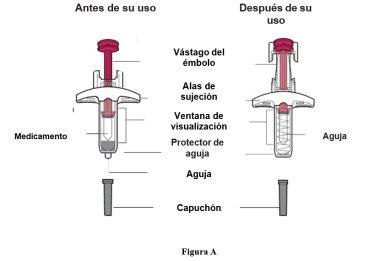
Підготовка до ін'єкції
ВАТНА ПАЛІЧКА З АЛКОГОЛЕМ |
Не входить до складу коробки:
| |
Коробка, що містить вату або марлю та шприц з алкоголем для ін'єкції | ||
| ||
Пластиковий контейнер для вколюючих предметів | ||
Рисунок Б |
| |
Рисунок В |
| |
30
Рисунок Г |
|
Рисунок Д |
| |
|
| |
Рисунок Є | ||
= Самовприскування і опікун Рисунок Ж |
|
Рисунок З |
| |
|
| |
Рисунок І |
Введення ін'єкції
Рисунок КНевикористовуйте шприц, якщо він впав без ковпачка голки на місці. Якщо це трапилося, зверніться до вашого лікаря або фармацевта.
|
Рисунок Л |
Рисунок М |
Рисунок Н |
Після ін'єкції
|
Рисунок ОЛікарські засоби неповинні викидатися у водопровідну систему чи сміття. Спитайте у вашого фармацевта, як позбутися лікарських засобів, які вам більше не потрібні. Це допоможе захистити навколишнє середовище. |
- Країна реєстрації
- Діючі речовини
- Потрібен рецептТак
- Виробник
- Інформація є довідковою і не є медичною порадою. Перед прийомом будь-яких препаратів обов'язково проконсультуйтеся з лікарем. Oladoctor не несе відповідальності за медичні рішення, прийняті на основі цього контенту.
- Альтернативи до СТЕКЕЙМА 45 мг Розчин для ін'єкцій у попередньо заповненому шприціФорма випуску: РОЗЧИН ДЛЯ ІНФУЗІЙ, ЩО ВВОДИТЬСЯ ІН'ЄКЦІЙНО, 130 мгДіючі речовини: ustekinumabВиробник: Accord Healthcare S.L.U.Потрібен рецептФорма випуску: РОЗЧИН ДЛЯ ІН'ЄКЦІЙ, 45 мгДіючі речовини: ustekinumabВиробник: Accord Healthcare S.L.U.Потрібен рецептФорма випуску: РОЗЧИН ДЛЯ ІН'ЄКЦІЙ, 90 мгДіючі речовини: ustekinumabВиробник: Accord Healthcare S.L.U.Потрібен рецепт
Лікарі онлайн щодо СТЕКЕЙМА 45 мг Розчин для ін'єкцій у попередньо заповненому шприці
Консультація щодо дозування, побічних ефектів, взаємодій, протипоказань та поновлення рецепта на СТЕКЕЙМА 45 мг Розчин для ін'єкцій у попередньо заповненому шприці – за рішенням лікаря та згідно з місцевими правилами.







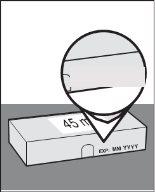 КІНЦЯ: ММ/РРРР
КІНЦЯ: ММ/РРРР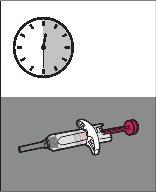 хвилин
хвилин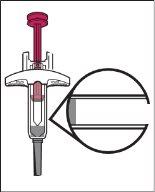 КІНЦЯ: ММ/РРРР
КІНЦЯ: ММ/РРРР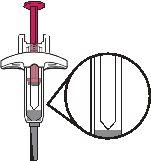
 = ТІЛЬКИ опікун
= ТІЛЬКИ опікун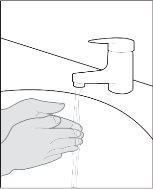
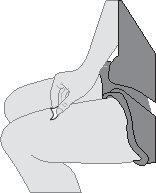
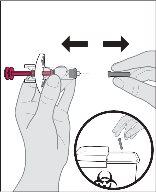 Видаліть ковпачок.
Видаліть ковпачок.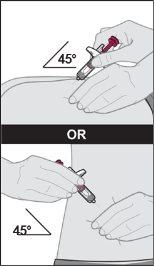 АБОглибоко (в м'яз).
АБОглибоко (в м'яз).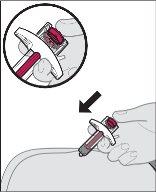 Введіть ін'єкцію.
Введіть ін'єкцію.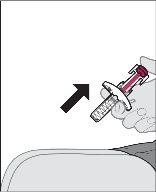 Видаліть шприц з місця ін'єкції.
Видаліть шприц з місця ін'єкції.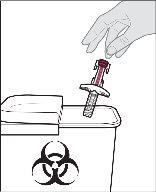 Видалення Steqeyma.
Видалення Steqeyma.

